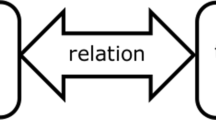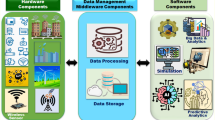Abstract
Digital Twins has been defined as a virtual representation of a real system, with validation links capable of granting an association and functional equivalence between the “twins,” even simultaneously or with a real-time delay. The virtual counterpart should be a model that must contain all essential issues, operations, and processes to reproduce the behavior of its twin, avoiding unnecessary overhead. Typically, this approach is applied to engineering systems, mainly in Industry 4.0. The idea to apply a similar framework to plant and forest ecology analysis just fit the interests of many research labs, including the Research Center for Greenhouse Gas Innovation (RCGGI), to study formal models for greenhouse gas emissions, sinks and carbon balance along the complex Amazonian ecosystem. A framework was proposed to study the Brazilian Amazon Forest, shared by a multidisciplinary arrangement of Brazilian research groups and connected with other global partners. The proposal connects large data collectecton from several approaches used by distinct research groups, government agencies, and international institutions into a data system supporting service science processes. The primary investigation looks for a conceptual framework for Digital Twins to support a research agenda towards a life cycle analysis that allows an incremental and compositional enhanced view of processes affecting the Amazonian ecosystem.





Similar content being viewed by others
Data Availability
After test the DTC will be available in the link https://www.rcgi.poli.usp.br/project-greenhouse-gas-emissions-inamazon-and-data-analytics-and-service-system/
References
Anderson V, McLean R (2019) Design of experiments: a realistic approach. Taylor & Francis, London. https://doi.org/10.1201/9781315141039
Barata J, Pereira V, Coelho M (2020) Product biography information system: a lifecycle approach to digital twins. IEEE Trans Syst Man Cybern Syst 2020-Octob:899–904. https://doi.org/10.1109/SMC42975.2020.9283061
Deuter A (2019) The digital twin theory: designing a test infrastructure using SysML. Deuter, Andreas (October)
Dickopf T, Apostolov H, Müller P, Göbel JC, Forte S (2019) A holistic system lifecycle engineering approach - Closing the loop between system architecture and digital twins. Procedia CIRP 84:538–544
Digital Twin Computing Research Center, NTT (2021) The digital twin computing reference model. Technical Report March, NTT Research Center
Erl T (2016) SOA principles of service design. Prentice Hall, Crowdsforville, Indiana, p 781
Fan X, Luo Y (2020) Value co-creation: a literature review. Open J Soc Sci 8. https://doi.org/10.4236/jss.2020.82008
Gabrys J (2020) Smart forests and data practices: from the internet of trees to planetary governance. Big Data Soc 7(1). https://doi.org/10.1177/2053951720904871
García O (2013) Forest stands as dynamical systems: an introduction. Mod Appl Sci 7(5):32–38. https://doi.org/10.5539/mas.v7n5p32
Grieves M, Vickers J (2016) Digital twin: mitigating unpredictable, undesirable emergent behavior in complex systems. Transdisciplinary Perspectives on Complex Systems: New Findings and Approaches (August) 85–113
INCOSE (2021) SEBoK - System Engineering Book of Knowledge. Int. Council on Systems Engineering. https://www.sebokwiki.org/wiki/Download_SEBoK_PDF Accessed 21 Nov 2021
Juarez MG, Botti VJ, Giret AS (2021) Digital twins: review and challenges. J Comput Inf Sci Eng 21(3). https://doi.org/10.1115/1.4050244
Kruid S, Macedo MN, Gorelik SR, Walker W, Moutinho P, Brando PM, Castanho A, Alencar A, Baccini A, Coe MT (2021) beyond deforestation: carbon emissions from land grabbing and forest degradation in the Brazilian Amazon. Front For Glob Change 4(July). https://doi.org/10.3389/ffgc.2021.645282
Lim KYH, Zheng P, Chen CH (2020) A state-of-the-art survey of digital twin: techniques, engineering product lifecycle management and business innovation perspectives. J Intell Manuf 31:1313–1337. https://doi.org/10.1007/s10845-019-01512-w
Liu M, Fang S, Dong H, Xu C (2021) Review of digital twin about concepts, technologies, and industrial applications. J Manuf Syst 58(PB):346–361. https://doi.org/10.1016/j.jmsy.2020.06.017
Mitchell AL, Rosenqvist A, Mora B (2017) Current remote sensing approaches to monitoring forest degradation in support of countries measurement, reporting and verification (MRV) systems for REDD+. Carbon Balance Manag 12(1). https://doi.org/10.1186/s13021-017-0078-9
Mytton D (2020) Assessing the suitability of the greenhouse gas protocol for calculation of emissions from public cloud computing workloads. J Cloud Comput 9. 10.1186/s13677-020-00185-8
Nakamura T (2020) Digital twin computing initiative. Technical Report 9, NTT Research Center
Negri E, Fumagalli L, Macchi M (2017) A review of the roles of digital twin in CPS-based production systems. Procedia Manuf 11(June):939–948. https://doi.org/10.1016/j.promfg.2017.07.198
Oliveira VC, Silva JR (2015) A service-oriented framework to the design of information system service. J Serv Sci Res 7(2):55–96. https://doi.org/10.1007/s12927-015-0003-2
Orellana MA, Silva JR, Pellini EL (2021) A model-based and goal-oriented approach to the conceptual design of smart grid services. Machines 9(12)
Qiu R (2014) Service Science: the foundations of service engineering and management. John Wiley & Sons, Inc, New Jersey, USP, p 336. https://doi.org/10.1002/9781118551820
Siderska J, Jadaan KS (2018) Cloud manufacturing: a service-oriented manufacturing paradigm. A review paper. Eng Manag Prod Serv 10(1):22–31. https://doi.org/10.1515/emj-2018-0002
Silva JR, del Foyo PMG (2012) Timed petri nets. In: Pawlewlski P (ed) Petri Nets - Manufacturing and Computer Science. IntechOpen, London. https://doi.org/10.5772/50117
Silva JM, del Foyo PMG, Olivera AZ, Silva JR (2022) Revisiting requirement engineering for intelligent manufacturing. International Journal on Interactive Design and Manufacturing (IJIDeM) 1–14
Silva JR, Macedo ECT, Correa YG, Medeiros RF (2021) A multilayer proposal to a smart home applied to healthcare. Polytechnica 4. https://doi.org/10.1007/s41050-021-00029-7
Silva JM, Silva JR (2019) A new hierarchical approach to requirement analysis of problems in automated planning. Eng Appl Artif Intell 81:373–386
Sharma A, Kosasih E, Zhang J, Brintrup A, Calinescu A (2020) Digital twins: state of the art theory and practice, challenges, and open research questions. ArXiv abs/2011.02833
Sjarov M, Lechler T, Fuchs J, Brossog M, Selmaier A, Faltus F, Donhauser T, Franke J (2020) The digital twin concept in industry - a review and systematization. IEEE Symposium on Emerging Technologies and Factory Automation, ETFA 2020-Septe:1789–1796. https://doi.org/10.1109/ETFA46521.2020.9212089
Tao F, Qi Q, Wang L, Nee AYC (2019) Digital twins and cyber-physical systems toward smart manufacturing and industry 4.0: correlation and comparison. Engineering 5:653–661. https://doi.org/10.1016/j.eng.2019.01.014
Tao F, Xiao B, Qi Q, Cheng J, Ji P (2022) Digital twin modeling. J Manuf Syst 64:372–389. https://doi.org/10.1016/j.jmsy.2022.06.015
Tao F, Zhang M, Nee, AYC (2019) Digital twin driven smart manufacturing, 1st edn. Elsevier, London, pp 1–230
Uhlenkamp J-F, Hribernik K, Wellsandt S, Thoben K-D (2019) Digital twin applications: a first systemization of their dimensions. IEEE ???, pp 1–8. https://doi.org/10.1109/ICE.2019.8792579
Vial G (2021) Understanding digital transformation. Routledge, London
Van Der Aalst WMP, Stahl C (2011) Modeling business processes: a Petri Net-oriented approach. MIT Press, Boston, p 386
Wonham WM, Ramadge PJ (1988) Modular supervisory control of discrete-event systems. Math Control Signals Syst 1:113–30
Wymore AW (1993) Model-based systems engineering. CRC Press, Boca Raton, Florida
Funding
The current work is part of a research project of the Research Center in Greenhouse Gas Innovation (RCGGI), which is funded by São Paulo State Research Foundation (FAPESP in Portuguese) and the National Petroleum Agency.
Author information
Authors and Affiliations
Corresponding author
Ethics declarations
Conflict of Interest
Not applicable.
Additional information
Publisher's Note
Springer Nature remains neutral with regard to jurisdictional claims in published maps and institutional affiliations.
Rights and permissions
Springer Nature or its licensor (e.g. a society or other partner) holds exclusive rights to this article under a publishing agreement with the author(s) or other rightsholder(s); author self-archiving of the accepted manuscript version of this article is solely governed by the terms of such publishing agreement and applicable law.
About this article
Cite this article
Silva, J.R., Artaxo, P. & Vital, E. Forest Digital Twin: A Digital Transformation Approach for Monitoring Greenhouse Gas Emissions. Polytechnica 6, 2 (2023). https://doi.org/10.1007/s41050-023-00041-z
Received:
Revised:
Accepted:
Published:
DOI: https://doi.org/10.1007/s41050-023-00041-z




